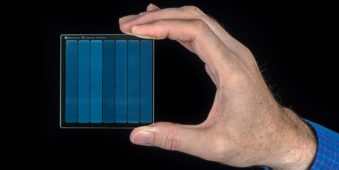Superman: The Movie is the first film to be preserved in a new glass-based storage technology.
Microsoft has partnered with Warner Brothers to preserve the 1978 classic superhero film in a first test case of a new type of data storage technology. The result is the ability to 75.6 gigabytes of data into a series of three-dimensional nanoscale gratings and deformations in a piece of silica glass measuring 7.5 cm by 7.5 cm by 2 mm.
Microsoft plans on unveiling the project at their Ignite 2019 conference in Orlando, Florida this coming Monday.
The choice of Superman: The Movie is an exceptionally fitting one. In the film, the technology of Superman’s homeplanet of Krypton and his arctic Fortress of Solitude both are based on glass-like crystals.
 In contrast to the silica glass, a single-layered blu-ray disc can hold up to 24 GB of data and a triple-layered disc can hold up to 100 GB. But the silica glass square developed by Microsoft’s “Project Silica” is exceptionally durable, showing extraordinary resistance to extreme changes in temperature as well as microwaves, water, demagnetization and even scouring with steel wool with no data loss. By contrast, a blu-ray disc or even a solid state memory card would be much more delicate.
In contrast to the silica glass, a single-layered blu-ray disc can hold up to 24 GB of data and a triple-layered disc can hold up to 100 GB. But the silica glass square developed by Microsoft’s “Project Silica” is exceptionally durable, showing extraordinary resistance to extreme changes in temperature as well as microwaves, water, demagnetization and even scouring with steel wool with no data loss. By contrast, a blu-ray disc or even a solid state memory card would be much more delicate.
“Glass has a very, very long lifetime,” Ant Rowstron, Microsoft Research principal researcher stated in an interview with Variety. “Thousands of years.”
Microsoft teamed with Warner Brothers on this project as the studio was looking for a longterm storage solution for their film and television assets. The studio is looking at the process as a way to ensure the preservation of what is known as “cold assets” – data that might not be needed to be accessed on a regular basis but instead could sit unattended for months, years or even decades. To date, the studio has some 20 million separate assets from its nine decades of operation, much of which could be considered “cold assets.”
As of right now, the technology seems to be firmly focused on archival use only and not for any consumer application. But if history has taught us anything, it is that as this technology becomes cheaper to make and easier to use, it will eventually transition into use for the general public.





